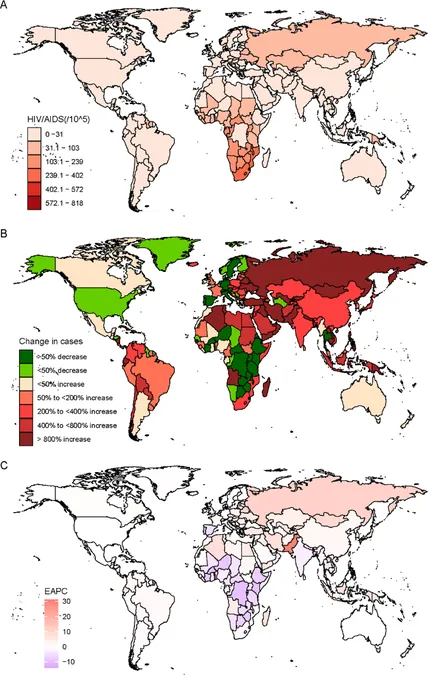
Unraveling the Global HIV/AIDS Crisis: Trends, Insights, and Future Projections
2025-05-24
Author: Wei Ling
A Closer Look at HIV/AIDS from 1990 to 2021
A new study provides a critical analysis of the HIV/AIDS epidemic, examining its global, regional, and national trends from 1990 to 2021. As the world grapples with various health crises, understanding the evolution of HIV/AIDS is essential for future prevention and treatment efforts.
Global Trends and Shifting Dynamics
In 2021, approximately 1.65 million people were newly infected with HIV/AIDS worldwide, according to estimates. This marked a gradual decline in new infections, with global rates showing a 0.14% annual decrease from 1990 to 2021. The burden, however, varies significantly by region and socioeconomic status, with southern sub-Saharan Africa bearing the brunt of the crisis.
Regions in Focus: Successes and Challenges
While southern sub-Saharan Africa maintained the highest incidence rates, countries like Burundi reported a remarkable decline of 97.86% in new cases due to targeted national strategies. Conversely, regions like Oceania are witnessing alarming increases in new cases, underscoring the need for tailored interventions.
Aging Populations: Who Is Most Affected?
The data reveal troubling trends among young adults, with individuals aged 25-29 experiencing the highest incidence rates globally. Notably, unsafe sexual practices remain the leading contributor to new infections, emphasizing a critical area for preventive measures.
Projections for 2030: A Tenuous Road Ahead
Looking to the future, projections indicate a continued decline in HIV/AIDS incidence and related health burdens. However, achieving the global targets set for 2030 will require unprecedented collaborative efforts in both funding and healthcare innovation. The study highlights that addressing the socioeconomic and educational disparities is vital for effective prevention.
Beyond the Numbers: The Socioeconomic Impact
The burden of HIV/AIDS is heavily influenced by the sociodemographic index of various regions. High-SDI (sociodemographic index) regions benefit from better healthcare access and education, while low-SDI areas continue to struggle due to a lack of resources and awareness.
The Gender Gap: Why Women Are Disproportionately Affected
Women, particularly those aged 15-24 in sub-Saharan Africa, face higher rates of infection due to various socio-cultural factors and vulnerabilities. Initiatives aimed at empowering women through education and healthcare access are essential to mitigate these risks.
Need for Comprehensive Interventions
The study emphasizes the importance of holistic approaches that integrate healthcare access with economic empowerment strategies. Effective programs, such as those in South Africa and Thailand, demonstrate that combining health education with economic support can significantly reduce risk and improve health outcomes.
Conclusion: A Call to Action
As the global community moves forward, addressing the underlying causes of HIV vulnerability—such as poverty and educational disparities—will be crucial. Only through targeted, multifaceted strategies can we hope to eliminate the AIDS epidemic and create a healthier future for all.


 Brasil (PT)
Brasil (PT)
 Canada (EN)
Canada (EN)
 Chile (ES)
Chile (ES)
 Česko (CS)
Česko (CS)
 대한민국 (KO)
대한민국 (KO)
 España (ES)
España (ES)
 France (FR)
France (FR)
 Hong Kong (EN)
Hong Kong (EN)
 Italia (IT)
Italia (IT)
 日本 (JA)
日本 (JA)
 Magyarország (HU)
Magyarország (HU)
 Norge (NO)
Norge (NO)
 Polska (PL)
Polska (PL)
 Schweiz (DE)
Schweiz (DE)
 Singapore (EN)
Singapore (EN)
 Sverige (SV)
Sverige (SV)
 Suomi (FI)
Suomi (FI)
 Türkiye (TR)
Türkiye (TR)
 الإمارات العربية المتحدة (AR)
الإمارات العربية المتحدة (AR)